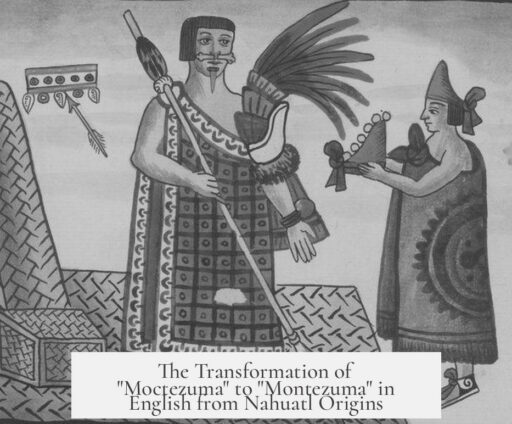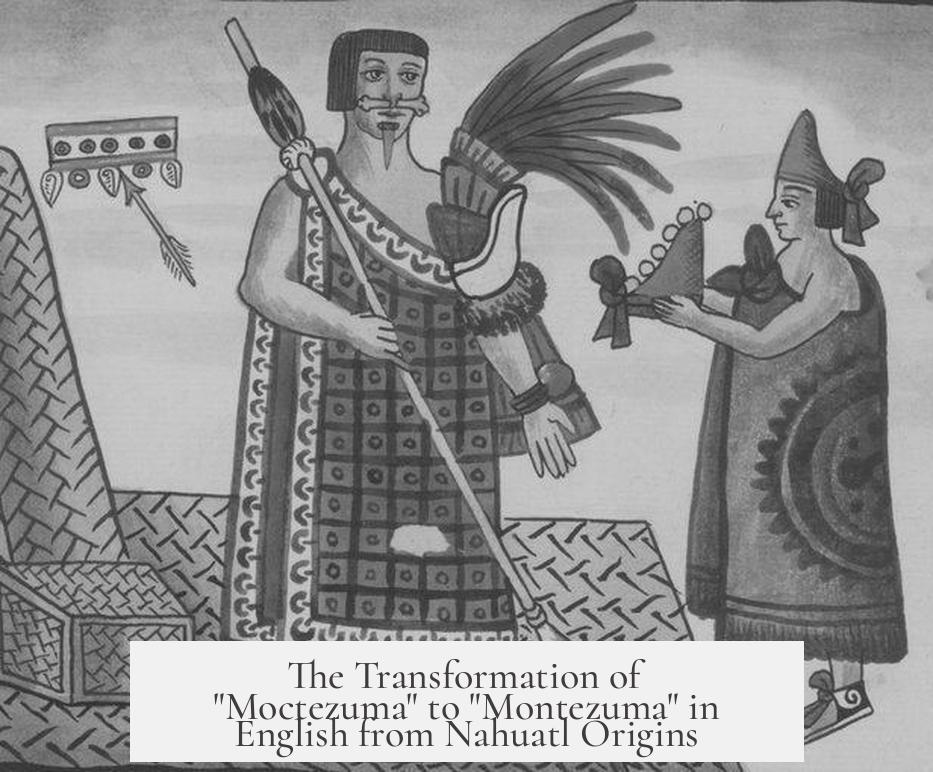The name “Moctezuma,” originally from Nahuatl, transforms into “Montezuma” in English mainly due to language adaptation processes involving Spanish and English phonetics and spelling conventions. The original Nahuatl name, closer to “Motecuhzoma,” shifts first in Spanish through metathesis, then in English through epenthesis and sound substitution, resulting in the form “Montezuma.”
The name originates in Nahuatl as Motecuhzoma or Motēuhzōmahtli, meaning “he who frowns like a lord” or “he who is angry in a noble manner.” Linguistically, this name combines mo (third-person possessive), tecuhtli (lord), and zoma (angry or frowning). Pronounced roughly as Mo-te-kw-so-ma, the Nahuatl version has four syllables and distinct phonemes not found in Spanish or English.
When Spanish speakers encountered this name, they adapted it to their phonetics and orthographic rules. Spanish often calls him “Moctezuma,” with a notable phonetic change: the order of the sounds “c” and “t” switches—referred to as metathesis. This switching is common across languages. For example, English speakers sometimes say “comfterble” instead of “comfortable,” switching consonants to make pronunciation easier.
In Spanish, this metathesis swaps the c and t sounds around the middle of the name. Hence, from something closer to Motecuhzoma, the name becomes spelled and pronounced as “Moctezuma.” This transformation reflects Spanish phonological preferences and conventions.
When the name entered English usage, it went through further changes. English speakers found the consonant cluster /okte/ uncommon and perhaps awkward to pronounce. Instead, the cluster shifted to /onte/, resembling the word “monte,” meaning “hill” in Spanish, which feels familiar to English speakers.
Moreover, the English form involves epenthesis, the insertion of an extra sound between existing sounds to ease pronunciation. In this case, an n sound is inserted intrusively between the o and t. This phenomenon occurs because the tongue’s position naturally moves from the back vowel o to the alveolar stop t, making the addition of the nasal n easier. This is comparable to how English speakers sometimes say “Thompson” as “Tompson,” inserting a consonant to simplify articulation.
English also maintains the t sound as unvoiced to keep it distinct, avoiding the voiced tap that might create confusion. Because the t stays unvoiced and prolonged, the nasal n becomes more likely as an intrusive consonant. Thus, “Moctezuma” evolved into “Montezuma,” a form shaped by English phonotactic rules and speaker preferences.
This linguistic path also reflects loanword adaptation principles. When languages borrow names or words, they adjust sounds and structure to fit their native sound patterns and speech habits. Differences in sound inventories and allowed syllable structures lead to changes such as metathesis and epenthesis. The alterations stabilize names in the borrowing language, resulting in name variants.
The differences across the two languages can be summarized as follows:
| Language Stage | Original Form | Change Type | Resulting Form | Reason |
|---|---|---|---|---|
| Nahuatl | Motecuhzoma | None (original) | Motecuhzoma | Original currency |
| Spanish | Motecuhzoma | Metathesis (c and t switch places) | Moctezuma | Spanish phonological rules |
| English | Moctezuma | Epenthesis (insertion of “n”), C dropped, phonetic adaptation | Montezuma | English phonotactics and common syllable patterns |
Historically, Spanish chroniclers sometimes rendered the Aztec emperor’s name as both Moctezuma and Montezuma. English literature adopted the latter more commonly despite it diverging from Nahuatl and Spanish origins. Modern scholarship tends to favor Moctezuma as a closer representation of the Spanish form, which itself is an approximation of the original Nahuatl.
The name “Montezuma” features often in English due to its long-standing use since early colonial accounts and popular culture. However, it represents a filtered version shaped by multiple linguistic interactions rather than the authentic Nahuatl pronunciation. The original meaning remains consistent through these stages: a reference to a ruler characterized by noble anger or stern authority.
- Moctezuma derives from Nahuatl Motecuhzoma, meaning “he who frowns like a lord.”
- Spanish altered the name via metathesis, switching “c” and “t” for ease of pronunciation.
- English further adapted the name by dropping the “c” and inserting an “n” for phonetic flow.
- Epenthesis and metathesis are common linguistic processes shaping loanwords to sound natural.
- The English “Montezuma” is widespread but less accurate than the Spanish “Moctezuma.”
Why is “Moctezuma” spelled as “Montezuma” in English?
The Spanish switched the order of the “c” and “t” sounds, a process called metathesis. English then dropped the “c” and added an “n,” making “Montezuma” more natural to English speakers.
What caused the “n” sound to appear in the English form “Montezuma”?
An intrusive “n” sound was added due to how English speakers pronounce the transition between vowel and consonant sounds. The tongue moves in a way that inserts the “n” for easier speech.
Did the original Nahuatl name sound like “Moctezuma” or “Montezuma”?
The original Nahuatl name was closer to “Motecuhzoma,” with different sounds than both the Spanish and English versions. It means “he who frowns like a lord.”
How did Spanish pronunciation influence the English name?
Spanish recorded the name with switched consonants (“Moctezuma”), and English borrowed from these forms. English adapted it further based on its own sound patterns.
Are “Moctezuma” and “Montezuma” both correct?
“Moctezuma” is correct in Spanish and closer to the original Nahuatl. “Montezuma” is an older English spelling that became common but is less accurate linguistically.
What linguistic processes explain changes from Nahuatl to English?
- Metathesis: switching sounds, like “ct” to “tc.”
- Epenthesis: adding sounds, such as the “n” in English.
- Adaptation to English pronunciation rules and common sound patterns.




